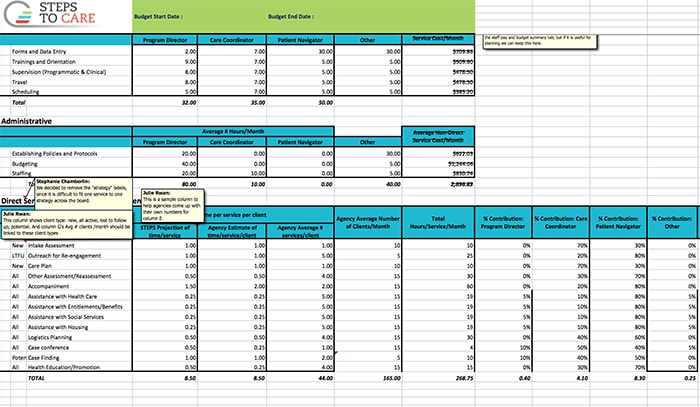STEPS to Care: Budgeting
Program Directors must allocate the proper resources and funds to implement the STEPS to Care program.
Creating a systematic budget for your agency’s STEPS program ensures the costs of staff pay, direct service implementation, non-direct service implementation, administration, and overhead are accounted for and managed.
This page includes a budgeting toolkit to help you plan your budget for STEPS and keep track of agency funding during implementation.
After using the budget resources below, you will know how to:
- Create and maintain a budget for STEPS to Care
- Identify cost categories associated with implementation of STEPS
Budget Toolkit

Creating a system for budgeting is an important way for Program Directors to stay on top of all budget needs.
Use the Budget Toolkit to:
- Report to partner organizations and agencies
- Inform your future implementation by helping you estimate the costs of carrying out each service
The Toolkit is a single Microsoft Excel spreadsheet with a glossary and three separate calculation sheets that can be used to generate an overall budget:
Staff Pay: Use this sheet to track the pay for the Program Director, Patient Navigator, Care Coordinator, and other staff members of the STEPS program. This includes both salaried employees and hourly rate employees.
Implementation Costs: Use this sheet to estimate the costs (with the staff pay information entered on the “Staff Pay” sheet) for the following categories and calculate the percent of contribution from different staff member types and the cost of implementing each service type:
- Direct service implementation with clients, which includes:
- Intake assessment
- Outreach for re-engagement
- Care plan
- Other assessment/reassessment
- Accompaniment
- Assistance with health care
- Assistance with entitlements/benefits
- Assistance with social services
- Assistance with housing
- Logistics planning
- Care team meetings
- Case finding
- HIV Self-Management
- Administrative, which includes:
- Establishing policies and procedures
- Budgeting
- Staffing
- Non-direct service implementation, which includes:
- Forms and data entry
- Training and orientation
- Supervision (programmatic and clinical)
- Travel
- Scheduling
Overhead Costs: Use this sheet to track overhead and service preparation costs for implementing the STEPS to Care program, such as printing, Internet access, and rent.



